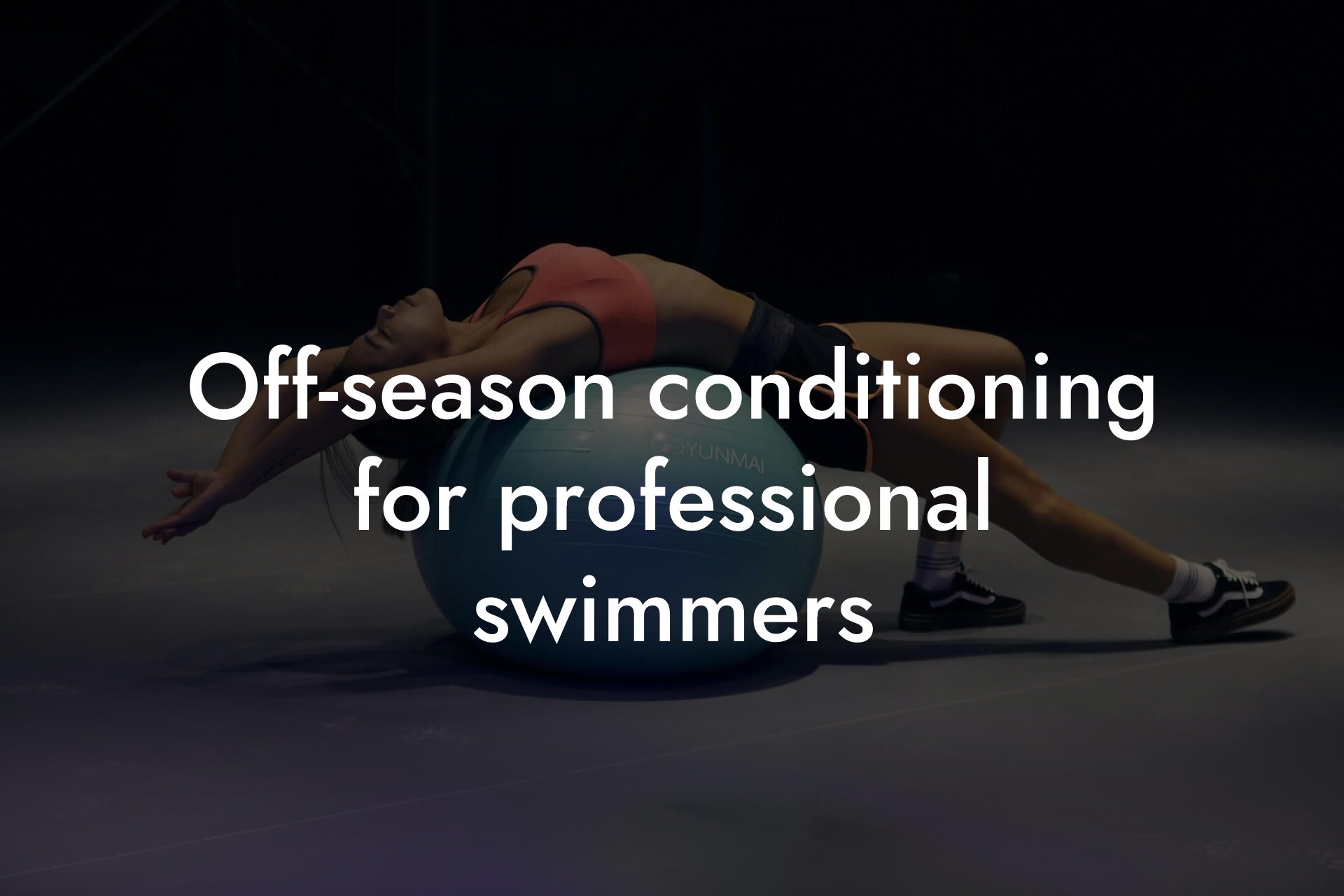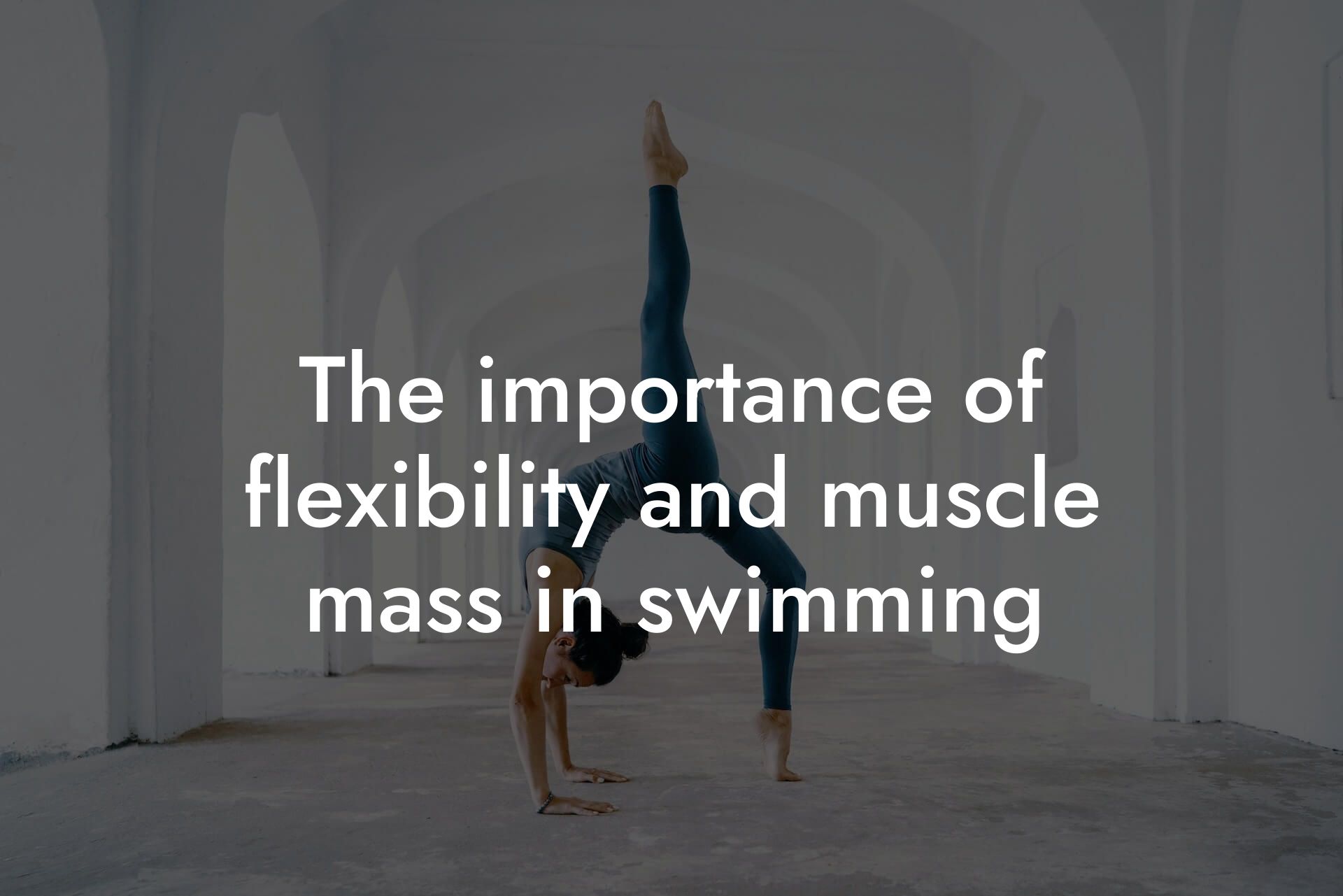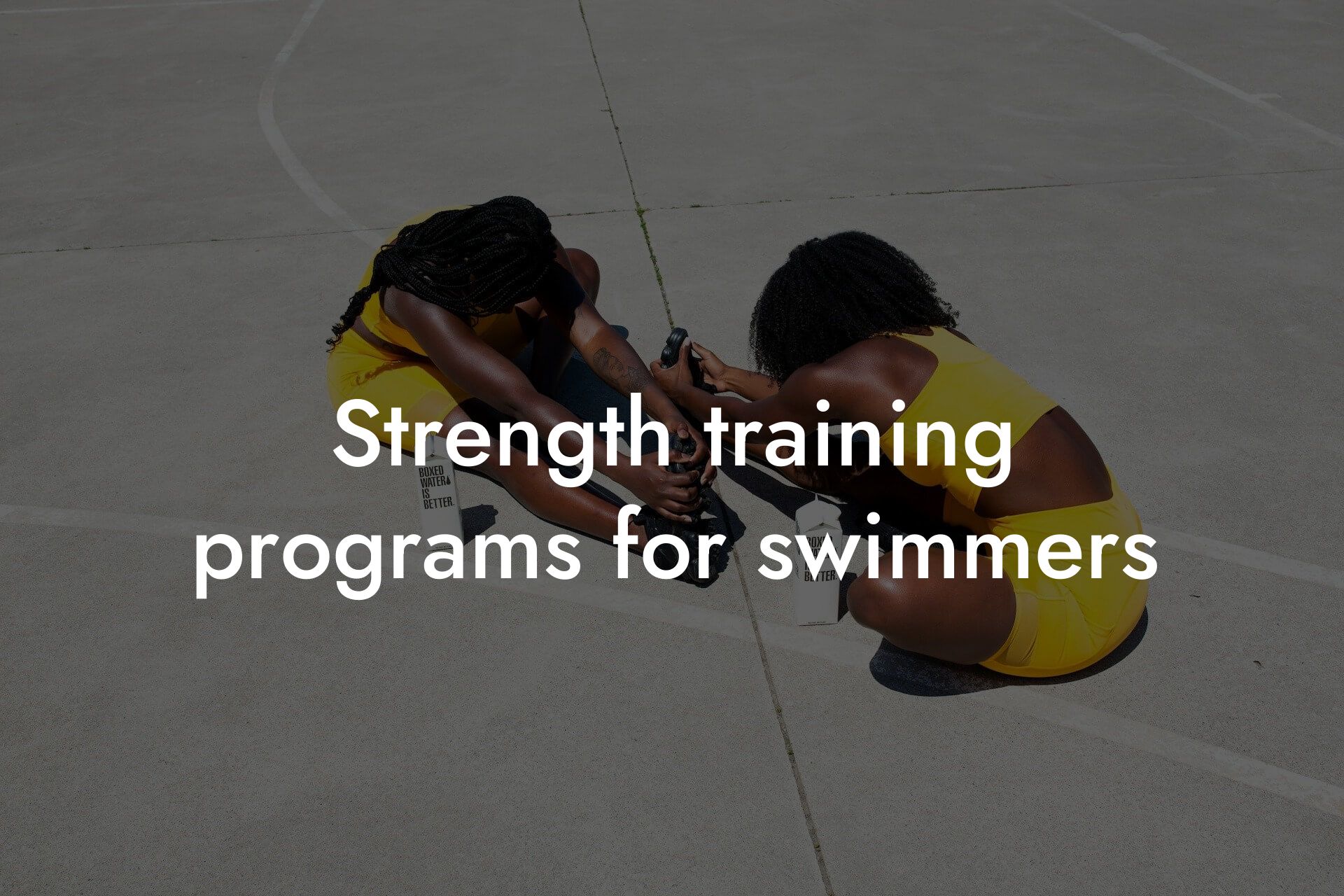As a high-earning professional, taking care of your physical appearance and physique is crucial for your overall well-being and performance. As a swimmer, you understand the importance of intense training to improve your skills and reach your goals. However, intense training can take a toll on your body, making recovery techniques essential to prevent injuries, improve performance, and maintain overall health. In this article, we will explore the best recovery techniques for swimmers after intense training.
Table of Contents
Understanding the Importance of Recovery
Recovery is a critical component of any training program, and it's often overlooked. When you engage in intense swimming training, your body undergoes physical stress, causing micro-tears in your muscles, tendons, and ligaments. If you don't allow your body time to recover, these micro-tears can lead to injuries, fatigue, and decreased performance. Recovery techniques help your body repair and rebuild tissues, replenish energy stores, and adapt to the physical demands of swimming.
Stretching and Foam Rolling
Stretching and foam rolling are two of the most effective recovery techniques for swimmers. Stretching helps to increase flexibility, reduce muscle tension, and improve range of motion. Focus on static stretches that target your shoulders, chest, back, hips, and legs. Hold each stretch for 20-30 seconds and repeat for 2-3 sets. Foam rolling is a self-myofascial release technique that helps to reduce muscle soreness and improve circulation. Use a foam roller to target your IT band, quadriceps, hamstrings, and glutes.
Cool Down and Warm Up
A proper cool down and warm up are essential for recovery. A cool down after intense training helps to gradually bring your heart rate and breathing back to normal, reducing the risk of dizziness and lightheadedness. Incorporate gentle swimming, stretching, or yoga poses into your cool down routine. A warm up before training prepares your body for physical activity, reducing the risk of injuries and improving performance. Include light cardio, stretching, and dynamic movements in your warm-up routine.
Compression Garments and Elevation
Compression garments, such as compression socks and sleeves, can help improve circulation and reduce muscle soreness. They work by applying gentle pressure to your muscles, which helps to push blood flow back towards your heart. Elevation is another effective recovery technique that involves elevating your legs above the level of your heart. This helps to reduce swelling and improve circulation, reducing muscle soreness and fatigue.
Cryotherapy and Heat Therapy
Cryotherapy, such as ice baths and cold water immersion, is a popular recovery technique among swimmers. It helps to reduce inflammation, muscle soreness, and improve circulation. However, it's essential to use cryotherapy in moderation, as excessive use can be detrimental to your training. Heat therapy, such as warm baths and saunas, can help to relax your muscles, improve circulation, and reduce muscle spasms.
Active Recovery Techniques
Active recovery techniques, such as light swimming, cycling, or using a stationary bike, can help to promote blood flow and reduce muscle soreness. These techniques are low-intensity and can be performed at a leisurely pace, making them an excellent way to recover from intense training. Active recovery techniques can also help to improve your cardiovascular fitness and burn excess calories.
Nutrition and Hydration
Nutrition and hydration play a critical role in recovery. After intense training, your body needs the right nutrients to repair and rebuild tissues. Focus on consuming a balanced diet that includes protein, complex carbohydrates, and healthy fats. Protein is essential for muscle repair and growth, while complex carbohydrates provide energy for your next training session. Adequate hydration is also crucial, as it helps to replenish lost fluids and electrolytes. Aim to drink at least 8-10 glasses of water per day.
Rest and Sleep
Rest and sleep are often overlooked recovery techniques, but they're essential for your body to repair and adapt to the physical demands of swimming. Aim to get at least 7-9 hours of sleep per night, and take rest days as needed. During rest days, avoid any strenuous activities and focus on relaxation techniques, such as meditation, yoga, or reading. Adequate rest and sleep can help to improve your performance, reduce the risk of injuries, and maintain overall health.
DEXA Scan and Body Composition Analysis
At Tano Performance Group, we understand the importance of tracking your body composition and physique. Our DEXA scan technology provides a comprehensive body assessment, giving you valuable insights into your body fat percentage, bone density, and muscle mass. With this information, you can tailor your training and nutrition program to optimize your performance and achieve your goals. By incorporating DEXA scan and body composition analysis into your recovery routine, you can gain a competitive edge and take your training to the next level.
Frequently Asked Questions
What is the importance of recovery techniques for swimmers after intense training?
Recovery techniques are crucial for swimmers after intense training as they help to reduce muscle soreness, improve flexibility, and enhance overall performance. Proper recovery allows swimmers to return to their optimal training state, reducing the risk of injury and improving their overall well-being.
What are some common signs of overtraining in swimmers?
Common signs of overtraining in swimmers include fatigue, decreased performance, muscle soreness, insomnia, and mood disturbances. If left unaddressed, overtraining can lead to more severe consequences such as injury, illness, and burnout.
How does stretching help in recovery for swimmers?
Stretching is an essential recovery technique for swimmers as it helps to improve flexibility, reduce muscle tension, and enhance range of motion. Regular stretching can also reduce the risk of injury and improve overall performance.
What are some effective stretching exercises for swimmers?
Some effective stretching exercises for swimmers include shoulder rolls, chest stretches, lat stretches, hip flexor stretches, and calf stretches. It's essential to focus on stretches that target the specific muscle groups used in swimming.
How does foam rolling help in recovery for swimmers?
Foam rolling is a self-myofascial release technique that helps to reduce muscle soreness, improve circulation, and enhance recovery. By applying pressure to specific areas, foam rolling can help to break down adhesions and scar tissue, promoting healthy muscle function.
What are some benefits of using a recovery pool for swimmers?
A recovery pool, also known as a contrast water therapy pool, provides a low-impact environment for swimmers to recover. The benefits of using a recovery pool include reduced muscle soreness, improved circulation, and enhanced recovery.
How does compression clothing help in recovery for swimmers?
Compression clothing, such as compression socks and sleeves, provides graduated compression that helps to improve circulation, reduce muscle soreness, and enhance recovery. By improving blood flow, compression clothing can help to reduce inflammation and promote healthy muscle function.
What are some benefits of using a massage gun for swimmers?
A massage gun is a handheld device that provides percussive therapy, helping to reduce muscle soreness, improve circulation, and enhance recovery. The benefits of using a massage gun include reduced muscle tension, improved range of motion, and enhanced athletic performance.
How does cryotherapy help in recovery for swimmers?
Cryotherapy, also known as ice baths, helps to reduce inflammation, improve circulation, and enhance recovery. By exposing the body to cold temperatures, cryotherapy can help to reduce muscle soreness, improve immune function, and promote healthy muscle function.
What are some benefits of using a sauna for swimmers?
A sauna provides a heat stress that helps to improve circulation, reduce muscle soreness, and enhance recovery. The benefits of using a sauna include improved cardiovascular function, reduced inflammation, and enhanced athletic performance.
How does nutrition play a role in recovery for swimmers?
Nutrition plays a critical role in recovery for swimmers as it provides the necessary building blocks for muscle repair and recovery. A balanced diet that includes protein, complex carbohydrates, and healthy fats can help to promote healthy muscle function, reduce muscle soreness, and enhance overall performance.
What are some essential nutrients for swimmers to aid in recovery?
Essential nutrients for swimmers to aid in recovery include protein, creatine, branched-chain amino acids (BCAAs), and omega-3 fatty acids. These nutrients help to promote healthy muscle function, reduce muscle soreness, and enhance overall performance.
How does hydration play a role in recovery for swimmers?
Hydration is critical for swimmers as it helps to regulate body temperature, transport nutrients, and remove waste products. Proper hydration can help to reduce muscle soreness, improve circulation, and enhance overall performance.
What are some tips for swimmers to stay hydrated?
Tips for swimmers to stay hydrated include drinking at least 8-10 glasses of water per day, consuming electrolyte-rich drinks, and monitoring urine color to ensure it's pale yellow or clear.
How does sleep play a role in recovery for swimmers?
Sleep is essential for swimmers as it provides the necessary time for muscle repair and recovery. During sleep, the body repairs and rebuilds muscle tissue, helping to reduce muscle soreness and improve overall performance.
What are some tips for swimmers to improve sleep quality?
Tips for swimmers to improve sleep quality include establishing a consistent sleep schedule, creating a relaxing bedtime routine, avoiding caffeine and electronics before bedtime, and creating a dark, quiet sleep environment.
How does mental recovery play a role in recovery for swimmers?
Mental recovery is critical for swimmers as it helps to reduce stress, improve focus, and enhance overall performance. Techniques such as meditation, visualization, and positive self-talk can help swimmers to recover mentally and prepare for competition.
What are some tips for swimmers to improve mental recovery?
Tips for swimmers to improve mental recovery include practicing mindfulness, setting realistic goals, and engaging in relaxation techniques such as deep breathing and progressive muscle relaxation.
How does active recovery play a role in recovery for swimmers?
Active recovery, such as light swimming or cycling, helps to promote blood flow, reduce muscle soreness, and enhance recovery. Active recovery can be an effective way to recover from intense training while still maintaining some level of physical activity.
What are some benefits of using a recovery supplement for swimmers?
Recovery supplements, such as protein powder and creatine, can help to promote healthy muscle function, reduce muscle soreness, and enhance overall performance. When combined with a balanced diet and proper training, recovery supplements can be an effective way to enhance recovery.
How does Tano Performance Group support swimmers in their recovery?
Tano Performance Group provides swimmers with the necessary resources and information to optimize their recovery. Our team of experts provides personalized coaching, training plans, and nutrition guidance to help swimmers achieve their goals and improve their overall performance.
What are some common mistakes swimmers make when it comes to recovery?
Common mistakes swimmers make when it comes to recovery include neglecting to stretch, failing to prioritize sleep, and not fueling their bodies with a balanced diet. By avoiding these common mistakes, swimmers can optimize their recovery and improve their overall performance.
How can swimmers incorporate recovery techniques into their daily routine?
Swimmers can incorporate recovery techniques into their daily routine by scheduling recovery sessions, prioritizing sleep and nutrition, and making time for stretching and foam rolling. By making recovery a priority, swimmers can optimize their performance and reduce the risk of injury.
Here are some related articles you might love...
- Off-season conditioning for professional swimmers
- The importance of flexibility and muscle mass in swimming
- Strength training programs for swimmers
- Using DEXA scans to optimize swimmer performance
- Bone density and its impact on injury prevention in swimming
- Balancing strength and endurance in swimming
- Nutrition strategies for swimmers to maintain energy levels
- The role of body composition in swimming speed and endurance
- Reducing body fat for better buoyancy and speed in swimming
Zak Faulkner
Zak Faulkner is a leading authority in the realm of physical health and body composition analysis, with over 15 years of experience helping professionals optimise their fitness and well-being. As one the experts behind Tano Performance Group, Zak has dedicated his career to providing in-depth, science-backed insights that empower clients to elevate their physical performance and overall health.
With extensive knowledge of DEXA technology, Zak specializes in delivering comprehensive body assessments that offer precise data on body fat, muscle mass, bone density, and overall physique. His expertise enables individuals to make informed decisions and achieve their fitness goals with accuracy and confidence. Zak’s approach is rooted in a deep understanding of human physiology, combined with a passion for helping clients unlock their full potential through personalised strategies.
Over the years, Zak has earned a reputation for his commitment to excellence, precision, and client-focused service. His guidance is trusted by top professionals who demand the best when it comes to their health. Whether advising on fitness programs, nutritional strategies, or long-term wellness plans, Zak Faulkner’s insights are a valuable resource for anyone serious about taking their health and fitness to the next level.
At Tano Performance Group, Zak continues to lead our Content Team revolutionising how professionals approach their physical health, offering unparalleled expertise that drives real results.




